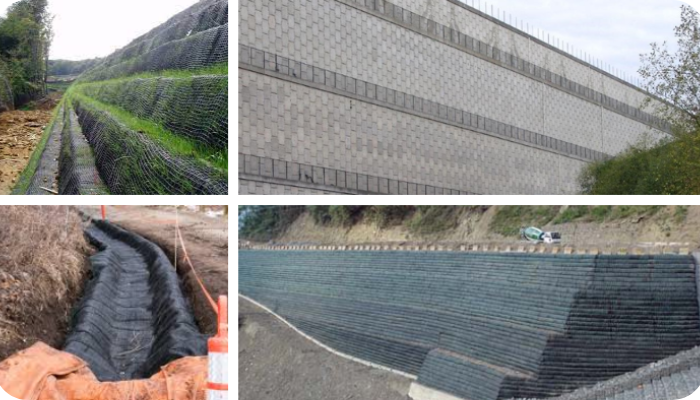Geosynthetics are a type of material used in civil engineering and construction projects to enhance the performance and stability of various types of infrastructure. These materials are made from synthetic polymers, such as polyethylene or polypropylene, and are used to reinforce and stabilize soil, rock, and other natural materials.
One of the main applications of geosynthetics in civil engineering is in the construction of retaining walls, embankments, and slopes. These materials are used to reinforce and stabilize soil, preventing erosion and landslides. They also help to improve the load-bearing capacity of the soil, allowing for the construction of taller and steeper walls and slopes.
Geosynthetics are useful in a wide range of construction areas, including:
- Retaining walls and slopes: Geosynthetics are used to reinforce and stabilize soil, preventing erosion and landslides. They also help to improve the load-bearing capacity of the soil, allowing for the construction of taller and steeper walls and slopes.
- Landfills: Geosynthetics are used to create a barrier between the waste in the landfill and the surrounding soil and water, preventing contamination and leakage. The liners and covers are made from layers of geosynthetic materials, such as geomembranes, geotextiles, and geocomposites, that work together to create a strong and durable barrier.
- Erosion control: Geosynthetics are used to stabilize and reinforce soil on slopes, riverbanks, and other areas prone to erosion.
- Drainage systems: Geosynthetics are used to create efficient and effective drainage systems, such as French drains and subsurface drainage systems.
- Pavement systems: Geosynthetics are used to reinforce and stabilize the base and subbase layers of pavement systems, improving their performance and longevity.
- Coastal engineering: Geosynthetics are used to protect and stabilize coastal areas, such as beaches and dunes, from erosion and storm damage.
The main benefits of geosynthetics in construction include:
- Enhanced performance and stability of infrastructure: Geosynthetics help to reinforce and stabilize soil, rock, and other natural materials, improving the performance and stability of the infrastructure being built.
- Improved load-bearing capacity: Geosynthetics can help to increase the load-bearing capacity of soil, allowing for the construction of taller and steeper walls and slopes.
- Reduced costs and maintenance: Geosynthetics can help to reduce costs and maintenance associated with infrastructure by preventing erosion and landslides, and by extending the lifespan of the infrastructure.
- Sustainability: Geosynthetics can help to prevent contamination and leakage, which leads to the sustainability of the environment.
- Versatility: Geosynthetics are used in a wide range of construction areas, making them a versatile and essential material in civil engineering and construction projects.
Geosynthetics are also commonly used in the construction of landfill liners and covers. These materials are used to create a barrier between the waste in the landfill and the surrounding soil and water, preventing contamination and leakage. The liners and covers are made from layers of geosynthetic materials, such as geomembranes, geotextiles, and geocomposites, that work together to create a strong and durable barrier.
In addition to these applications, geosynthetics are also used in a variety of other civil engineering and construction projects, including:
- Erosion control: Geosynthetics are used to stabilize and reinforce soil on slopes, riverbanks, and other areas prone to erosion.
- Drainage systems: Geosynthetics are used to create efficient and effective drainage systems, such as French drains and subsurface drainage systems.
- Pavement systems: Geosynthetics are used to reinforce and stabilize the base and subbase layers of pavement systems, improving their performance and longevity.
- Coastal engineering: Geosynthetics are used to protect and stabilize coastal areas, such as beaches and dunes, from erosion and storm damage
Overall, geosynthetics are a versatile and essential material in civil engineering and construction projects. They are used to enhance the performance and stability of various types of infrastructure and help to prevent erosion, landslides, and contamination, which leads to the sustainability of the environment.

Mayank Panchal is the founder of PIGSO Learning. He has many years of experience in teaching, curriculum development, and instructional designer in civil engineering, Mathematics, and digital marketing space. His passion for conceptual and deep research-based learning helps to understand the subject in depth.

